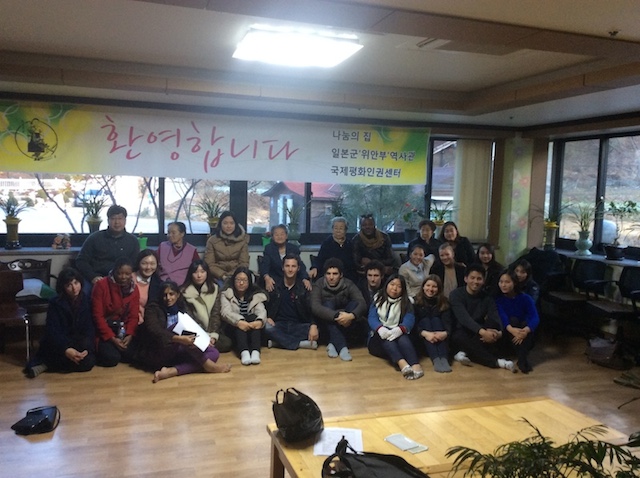Sex Slaves in Korea: Meeting World War II’s Comfort Women

 A couple of months ago I spent the afternoon at the House of Sharing learning more about Japan’s use of women during World War II. Located south of Seoul in Gwangju, the House of Sharing is home to several women who were used as sex slaves (“comfort women”). Since the women are elderly now, the House of Sharing provides a roof over their heads, meals and activities for them.
A couple of months ago I spent the afternoon at the House of Sharing learning more about Japan’s use of women during World War II. Located south of Seoul in Gwangju, the House of Sharing is home to several women who were used as sex slaves (“comfort women”). Since the women are elderly now, the House of Sharing provides a roof over their heads, meals and activities for them.
Sex Slaves in Korea: Meeting World War II’s Comfort Women
Background
The Japanese government was the ring leader in establishing comfort stations for military personnel. About 200,000 females were sent to many Asian countries, such as Cambodia, China, and Singapore. By sending females to far-flung locales it was easy to sever familial ties. The women were not allowed to speak Korean; thus, forced to learn whatever bits of a new language they could comprehend. In addition, they had to learn a new way of life in an unfamiliar culture.
Roughly 80% of the females brought into Asian countries were Korean. Many females were deceived into believing they would be hired for factory or nursing jobs during the war. (However, the reality they faced upon arrival to their new locations turned out to be worse than they could have imagined.) In addition, females as young as 13 years old were hauled off from the safety and comfort of their school environment to serve as comfort women.
The Halmonis
At the House of Sharing the elderly women are kindly referred to as halmonis. In Korean, halmoni means “grandmother.” These women are survivors and using such terms as comfort women is considered disrespectful. During the war the phrase “comfort women” was a label used by military personnel as a way to soften the horrific actions forced upon the women.
The tour began with a documentary about the women, particularly focusing on Kim Hak Soon, who was the first woman to publicize her experience as a wartime sex slave. After the documentary our guides led us around the grounds and the museum.
The museum consisted of numerous displays including a World War II timeline, maps of comfort stations in Asia, a room depicting a comfort station, a prayer area and large-scale paintings.
The prayer area’s walls were adorned with homemade items: paintings, colorful scarves, quilts and a map of Korea. Along the floor were vases filled with flowers, candles and porcelain jars. Our tour guide invited each of us to pay our respects to the deceased halmonis by lighting an incense stick and placing it inside the brass incense holder.
Sex Slaves in Korea: Meeting World War II’s Comfort Women
The display most poignant was located on the second floor. This floor was devoted to paintings and memorabilia that once belonged to the halmonis. Painting is strongly encouraged at the House of Sharing. For the halmonis it’s a cathartic activity, helping them deal with the tragic events from their past. One painting in particular that stood out illustrated a woman blindfolded and tied to a tree with three revolvers pointing at her from different directions. In the background white doves fluttered around the woman.
Later we were introduced to the halmonis. With the help of translators a few people asked questions about those devastating years. While some of the halmonis spoke calmly about the past, you could sense a lingering frustration that a few of them still have towards Japan. Some admitted to having occasional nightmares to this day.
As I sat listening and observing the frustrated halmonis, I could not help but think that even though Japan was largely responsible for establishing the comfort stations, South Korea has failed the women as well. After the war many women returned to Korea with little employment opportunities. Also, at that time seeking out mental health services would have had a social stigma attached to it. Even though they endured more than some of us will ever know (or understand), it was easy to catch a glimpse of an “elderly sparkle” in their eyes whenever they laughed.
The Aftermath
After World War II the Japanese government has repeatedly refused to pay compensation to the women. In 1995, the Asian Women’s Fund was established as a way for the Japanese government to mend the situation. However, contributions to the fund are provided by private donors and not by the Japanese government.
Since January 1992 many halmonis have gathered outside the Japanese Embassy in Seoul in protest of the Japanese government. In December 2013, to show their support of the halmonis, the South Korean government erected a statue called the Peace Monument. The statue portrays a young girl sitting in a chair and staring across the street at the Japanese Embassy. Perhaps this quiet reminder will eventually lead the Japanese government to stop “saving face” and genuinely acknowledge their past mistakes.

Sex Slaves in Korea: Meeting World War II’s Comfort Women
Have you traveled to Korea? How was your trip? Email us at [email protected] for information about sharing your experience and advice with the Pink Pangea community. We can’t wait to hear from you.
Sex Slaves in Korea: Meeting World War II’s Comfort Women photo credits: Rebecca B and Unsplash.








